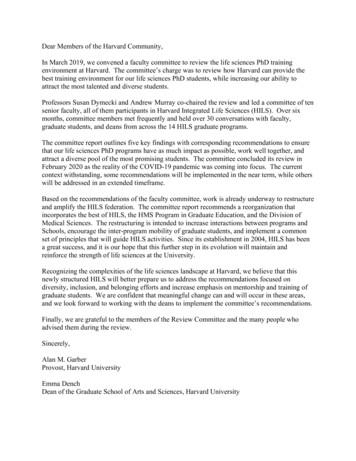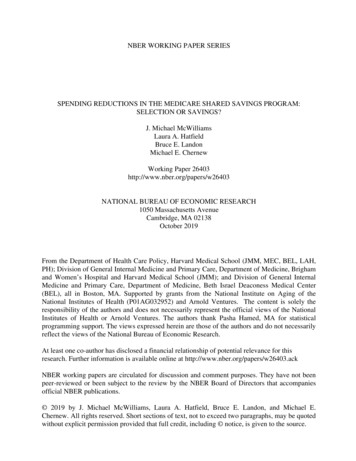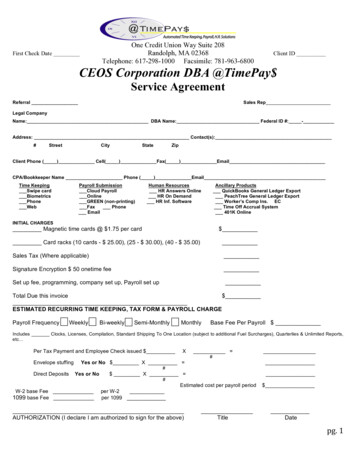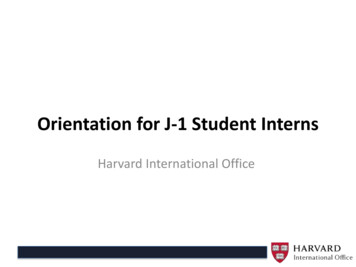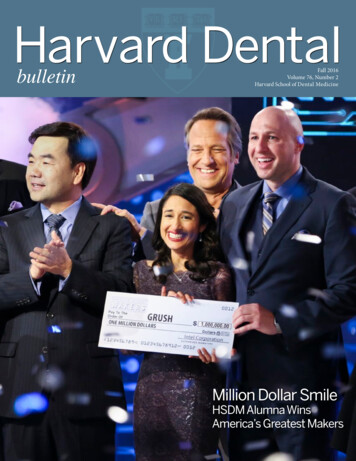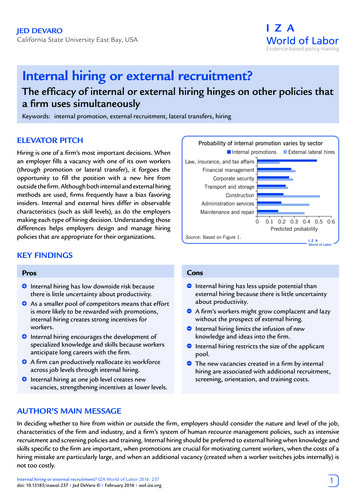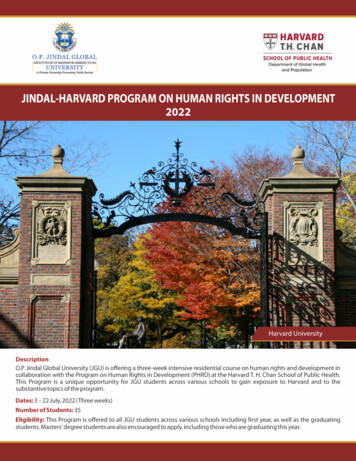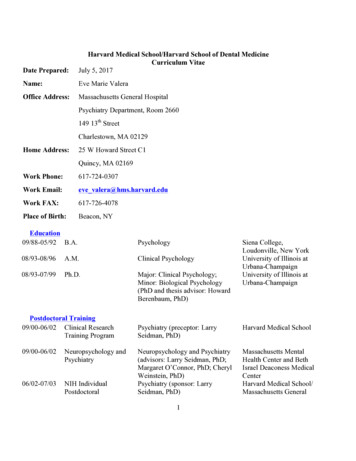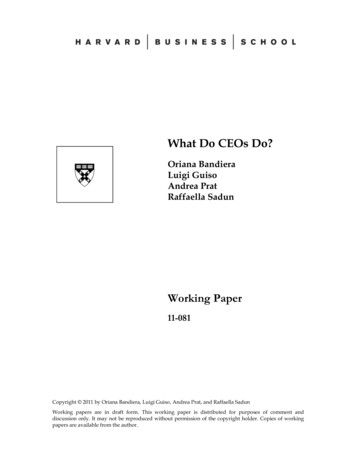
Transcription
What Do CEOs Do?Oriana BandieraLuigi GuisoAndrea PratRaffaella SadunWorking Paper11-081Copyright 2011 by Oriana Bandiera, Luigi Guiso, Andrea Prat, and Raffaella SadunWorking papers are in draft form. This working paper is distributed for purposes of comment anddiscussion only. It may not be reproduced without permission of the copyright holder. Copies of workingpapers are available from the author.
What Do CEOs Do? Oriana BandieraLondon School of EconomicsLuigi GuisoEuropean University Institute and EIEFAndrea PratLondon School of EconomicsRa aella SadunHarvard UniversityFebruary 25, 2011AbstractWe develop a methodology to collect and analyze data on CEOs’ time use. The idea —sketched out in a simple theoretical set-up — is that CEO time is a scarce resource and itsallocation can help us identify the firm’s priorities as well as the presence of governanceissues. We follow 94 CEOs of top-600 Italian firms over a pre-specified week and record thetime devoted each day to di erent work activities. We focus on the distinction betweentime spent with insiders (employees of the firm) and outsiders (people not employed bythe firm). Individual CEOs di er systematically in how much time they spend at workand in how much time they devote to insiders vs. outsiders. We analyze the correlationbetween time use, managerial e ort, quality of governance and firm performance, andinterpret the empirical findings within two versions of our model, one with e ective andone with imperfect corporate governance. The patterns we observe are consistent withthe hypothesis that time spent with outsiders is on average less beneficial to the firm andmore beneficial to the CEO and that the CEO spends more time with outsiders whengovernance is poor. We thank seminar participants at Catholic University of Milan, Columbia University, EEA Meetings,Harvard Business School, Imperial College, IMT Lucca, LSE, MIT, New York University, NIESR, UniversitatPompeu Fabra, Stockholm (IIES), and the University of Sussex for useful comments. We are grateful toTito Boeri, Daniel Ferreira, Luis Garicano, Steve Pischke, Imran Rasul, and Fabiano Schivardi for usefulsuggestions. This research was made possible by generous funding from Fondazione Rodolfo Debenedetti.1
1IntroductionTime management has been at the core of the research on management for almost fifty years.Peter Drucker (1966) makes it the centerpiece of his celebrated book on e ective management:“E ective executives know that time is the limiting factor. The output of any process is setby the scarcest resource. In the process we call ‘accomplishment’, this is time.”More recently, the importance of time constraints for people at the top of organizational hierarchies has been recognized by a number of economic models, like Radner and VanZandt’s work on hierarchies (surveyed in Van Zandt, 1998), Bolton and Dewatripont (1994),and Garicano (2000). Intellectual tasks — information processing in Radner-Van Zandt, communication in Bolton-Dewatripont, problem solving in Garicano — require managerial time,which is particularly scarce at the top of the organization.As a consequence, a key question in organization economics is whether and how managersallocate their time to maximize firm performance. The theoretical and practical interest,however, are not matched by adequate empirical evidence, as firm datasets typically containno information on managerial time use, while existing studies of managerial time use aremostly based on very few observations and have not been matched to firm level outcomes.This paper makes a step towards filling this gap by developing a methodology to systematically collect information on how CEOs allocate their time between di erent work activities.We develop a time-use diary for CEOs and we use it to record the time allocation of a sampleof 94 CEOs belonging to leading Italian companies in various industries over a pre-selectedwork week. A minimalistic model of managerial use of time guides our interpretation of observed di erences in time allocation patterns, and how these are related to the firms’ prioritiesand to di erences between the firms’ and the CEOs’ interests.To collect the time use data, we ask the CEO’s personal assistant (PA) to keep a diary ofthe activities performed by the CEO during a pre-specified week (from Monday to Friday).The PA has full information on the CEO’s schedule and he/she has a good understanding ofthe functions of the people that his/her boss interacts with.1 The PA reports overall workingtime and records in a diary all the activities of the CEO that last longer that 15 minutesdetailing their characteristics, in particular information on other participants.To operationalize the concept of time allocation, we group activities according to whetherthey involve employees of the firm (insiders) or only people external to the firm (outsiders).Insiders are listed by functional area, for instance finance, marketing, or human resources.1Roxanne Sadowski, Jack Welch’s long-term PA, makes this abundantly clear: “For more than fourteenyears, I’ve been human answering machine, auto dialer, word processor, filtering system, and fact checker;been a sounding board, schlepper, buddy, and bearer of good and bad tidings; served as a scold, diplomat,repairperson, cheerleader and naysayer; and performed dozens of other roles under the title of ‘assistant’.”2
Outsiders are grouped in categories CEOs normally interact with, for instance suppliers,investors, or consultants. The insider/outsider classification is ideal for our purposes for tworeasons. First, it captures the essence of the CEO’s job: “The CEO is the link between theInside that is the organization, and the Outside of society, economy, technology, markets, andcustomers ” (Drucker, cited in Lafley 2009). Second, it is a dimension over which the CEO’sand the firm’s interests might be misaligned. As a matter of fact, the optimal inside/outsidebalance is the subject of controversy in the management, finance and economics literature. Atone end of the spectrum, a widely held view is that since the CEO is the "public face" of thecompany, spending time outside the firm is an important (if perhaps not the most important)role of the CEO. 2 At the other end, however, an increasingly popular view points out thattime spent with outsiders might mostly benefit the CEO without contributing to creatingvalue for the firm. Khurana (2002), for instance, argues that CEOs have strong incentivesto seek visibility, by cultivating personal connections with influential business leaders. Inline with this, Malmendier and Tate (2009) show that when their power vis-a-vis the firmincreases, CEOs spend more time outside the firm in activities, such as writing books andplaying golf, and that this shift in activities does not contribute to firm’s performance.3Our data reveal that, as expected, CEOs spend the majority of their time with otherpeople (85%). Of these most are employees of the same firm, but many are not. On average,CEOs spend 42% of their time with insiders only, 25% with both insiders and outsiders and16% with outsiders alone. More interestingly, these averages hide a great deal of heterogeneity,both in terms of number of hours worked and time allocation. A majority of CEOs spendvery little time (less than 5 hours per week) alone with outsiders, but over 10% of themspend over 10 hours a week. Our empirical analysis is aimed at making sense of the wideheterogeneity on this dimension of time allocation choices.Since the implication of di erent time allocation choices - and in particular the di erential impact of time spent with insiders vs. outsiders - is a priori ambiguous, we developa minimalistic model of managerial time allocation that allows us to distinguish productiveactivities from activities that mostly confer private benefits to the CEO. We use this framework to shed light on whether time with insiders and outsiders can be interpreted along theselines. In our model, the CEO chooses how much time to devote to a number of possible2Procter & Gamble’s CEO A. G. Lafley (2009) views the link with the outside as the raison d’être of thetop executive: “The CEO alone experiences the meaningful outside at an enterprise level and is responsiblefor understanding it, interpreting it, advocating for it, and presenting it so that the company can respond ina way that enables sustainable sales, profit, and total shareholder return (TSR) growth.”3Khurana (2002)’s view is that the market for CEOs is deeply flawed. The search for external, charismatic“corporate saviors” leads boards — and the executive search companies they employ — to give their preferenceto highly visible personalities that can more easily be "sold" to the firm shareholders. In turn, this creates anincentive for CEOs to seek visibility, by cultivating personal connections with influential business leaders.3
work-related activities, or to leisure. Each of the work activities yield non-negative benefitsto the firm and to the CEO. For instance, networking with clients might increase the firm’ssale but also increase the chance that the CEO is o ered a better job in the future. Supposeactivities can be roughly divided into the ones that benefit mostly the firm and those thatbenefit mostly the CEO. In this set-up, the interpretation of di erences in time allocationbetween these two sets of activities depends on the extent to which the CEO’s and the firm’sinterests are aligned. When these are perfectly aligned, time allocation is entirely determinedby the firm’s objectives. In this case, the observed variation in time allocation is entirely determined by optimal responses to di erent conditions faced by di erent firms. However, whenthe CEO’s and the firm’s interests are not perfectly aligned, time allocation is determined byboth the firm’s objectives and the CEO’s objectives. In this case, the observed variation intime allocation partially reflects di erences in the quality of governance that determines thealignment of the CEO’s interests with the firm’s.If the observed variation reflects di erences in governance, the model makes precise thatthe following three sets of correlations must hold:1. CEOs who work longer hours, devote more time to activities that mostly benefit thefirm and less time to activities that mostly yield private benefits.2. CEOs who work for firms with stronger governance devote more time to activities thatmostly benefit the firm and less time to activities that mostly yield private benefits.3. Time devoted to activities that mostly benefit the firm is more strongly correlated withproductivity than time devoted to activities that mostly yield private benefits.Guided by the theoretical framework, we estimate the correlation between the CEOs’ timeuse, their total time at work, firm level measures of governance and productivity, conditionalon the size of the firm, whether it is listed and the industry it is in. The analysis yields threekey findings, corresponding to results 1-3 above.First, the insider/outsider allocation is associated with systematic di erences in CEOworktime. In particular, CEOs who work longer hours spend more time with insiders andless time, in absolute terms, with outsiders, especially in on one-on-one meetings.Second, the insider/outsider allocation is systematically correlated with di erences infirm governance. More precisely, we correlate CEOs time allocation with a range of externalproxies for firm level governance. We begin by comparing the time allocation of CEOs workingfor domestic and multinational firms. We expect the latter to have stronger governance asmultinational firms face global competition and therefore need to provide steeper incentivesto maintain their productivity advantage (Bloom and Van Reenen 2010 and Bandiera et. al4
2010). We then look at variables that proxy for the CEO’s power vis-a-vis the firm owners.First, we compare external CEOs who work for family firms to those hired by firms ownedby disperse shareholders. Intuitively, when ownership is concentrated, as it is in family firms,owners might face less di culties in monitoring the CEOs’ time use. Second, we test whethertime allocation is correlated with board size. Large boards have long been suspected of beingdysfunctional and to lead to too little criticism of management performance, thus grantingCEOs more freedom (e.g. Lipton and Lorsch, 1992). Consistent with this view, there issome evidence that larger boards reduce the value of the firm (e.g. Yermack, 1996). Third,following a recent literature pointing at the fact that the presence of women on the boardmight improve the quality of governance (Adams and Ferreira 2009), we use an indicatorfor whether there is at least a woman in the board with an executive role. Finally, as amore direct (and arguably exogenous) measure of governance quality and restraints on themanagers we use the country-level indicator of private benefits of control computed by Dyckand Zingales (2004) on the basis of block control transactions in 39 countries. We attachthis measure of quality of governance to multinational firms in our sample on the basis oftheir country of origin and rely on within variation among multinational firms operating inItaly. The correlations between time use and the five independent governance proxies painta consistent picture: CEOs who work for firms with better governance devote more time toinsiders and less time to meeting outsiders alone.In the final part of our empirical analysis, we show that the insider/outsider allocationis correlated with firm performance. Time spent with insiders is positively correlated withseveral measures of firm performance, while time spent with outsiders only is not. Forexample, a one percent increase in hours dedicated to insiders is correlated with a productivityincrease of 1.22%, whereas a one percent increase in hours dedicated to outsiders is correlatedwith a productivity increase of 0.22%, and both e ects are significantly di erent from zeroat conventional levels.Taken together, our findings are consistent with the idea that di erences in time allocationreflect di erences in governance and that, compared to time spent with outsiders alone, timespent with insiders is more beneficial to the firm. Since the data at hand, however, is notsuited to identify the causal e ect of governance on time allocation, we can make precise theset of assumptions needed to reconcile the findings with the view that di erences in timeallocation reflect optimal responses to di erent shocks faced by di erent firms. The finalsection of the paper discusses these in detail.The paper is structured as follows. After a brief literature review in Section 2, Section3 explains our empirical methodology and describes the data. Section 4 presents a simpletime allocation model. Section 5 reports empirical findings based on our theoretical set-up.5
Section 6 concludes.2Related LiteratureThe interest in the use of time of top executives is not new in the management literature4 . Theseminal work of Mintzberg (1973), based on intensive daily observation of five managers over aperiod of five weeks, provided an in-depth characterisation of the type of activities undertakenby executives, as well as the first documented evidence of the extreme fragmentation andunpredictability of their daily routines. In a similar spirit, Kotter (1982), studied fifteen highlevel general managers over a range of nine US corporations using three in depth interviewsconducted over a period lasting between six and twelve months, to document how the presenceof a flexible agenda allows executives to gather information and build networks within thefirm. More recently, Nohria and Porter (2009), studied the daily activities of a top US CEOover three full months. Although these studies have clearly played an important role inproviding evidence on the nature of managerial work, they are all based on very small andselected samples of individuals, a feature that ultimately limits the generalizability of theirfindings. Furthermore, they almost exclusively focus on US based executives. Our paperdirectly addresses these limitations providing, to the best of our knowledge, the first largescale evidence on CEO time use in an international context.The collection and analysis of time use data has experienced a recent surge also in theeconomics literature, with papers that have been mostly interested in shedding light on thework/leisure choice of employees, and in measuring on the job welfare (see, e.g. Aguiar andHurst 2007, Krueger et al 2009). Closer to our paper are Hamermesh (1990) and Luthans(1988), who analyse how workers and middle managers, respectively, spend time at work.Hamermesh (1990) analyzes time diaries of a sample of 343 US workers to shed light whethertime devoted to leisure on-the-job (e.g. on breaks) is productive for the firm, or an indicatorof shirking. Luthans (1988) records in detail the activities of 44 managers with the aim toidentify the determinants of a manager’s success within his or her organization. Althoughthis literature has also provided a very rich set of information on the nature of managerialactivities, it has not directly tested the implications of di erent time use allocations for firmperformance, which is one of the key contributions of our paper.Our analysis is also related to the vast literature that focuses on agency problems for CEOs(see the survey by Stein (2003)). Our paper studies one particular form of moral hazard,that relates to the diversion of CEOs time allocation, and hence it is quite far from other4See Hales (1986) for an extensive review of works focusing on the use of time of managers in the management literature.6
types of misbehavior studied in the literature. The most closely related study is Malmendierand Tate (2009), who look at what happens when CEOs receive prestigious business awards,both in terms of firm performance and CEO behavior. One of their findings is that awardrecipients appear to devote more time to writing books, playing golf, and sitting on boardsof other companies, a finding that is not inconsistent with ours in so far time to write bookscrowds CEO’s out working time rather than his leisure.Finally, we see our paper as complementary to Bertrand and Schoar’s (2003) analysis ofmanagement style in a panel of matched CEO-firm observations. While their objective is toidentify the fixed e ect of individual managers, our goal is to use a direct behavior variable- time allocation - to make inferences on the implicit incentive structure that managers face.33.1The CEOs’ Diaries: Descriptive Evidence on Time UseSources and Sample DescriptionOur main data source is a time use survey, which we designed to identify the activities CEOsengage in on a day-to-day basis. The survey e ectively shadows the CEO through his PAfor every day over a one week period. The PA is asked to record real-time information onall the CEO’s activities that last 15 minutes or longer in a time use diary. Table A1 showshow the diary is structured. For each activity - defined as a task to which the CEOs devotestime in excess of 15 minutes - the diary records information on the type of activity (e.g.meetings, phone calls etc), its duration, its location, whether it was scheduled in advanceand when, whether it is held regularly and how often. The diary also collects informationon the number of participants, whether these belong to the firm or not, and if insiders,their occupational areas (e.g. finance, marketing); if outsiders, their relation to the firm(e.g. investors, suppliers). The PA is also asked to record the total time the CEO spendsin activities that last 15 minutes or less and in transit. Hence, by summing the time spentover activities in excess of 15 minutes and the time spent in activities that last less than 15minutes we obtain a measure of the CEO total working time. Each PA is randomly assignedone of five weeks between February 10 and March 14, 2007.The master sample contains the top 800 Italian firms from the Dun&Bradstreet database (2007) and the top 50 Italian banks from the list of all major Italian financial groupscompiled yearly by the Research Division of Mediobanca, a leading Italian investment bank.Size is measured as yearly revenue for firms and as the average of (i) employment, (ii) Stockmarket capitalization; (iii) Total value of loan portfolio for banks. All 850 institutions werecontacted to ascertain the identity and contact details of the CEO; this procedure yielded 720complete records. Of these, 50 were randomly selected for a pilot survey and the remaining7
670 formed the final sample. The response rate was 18%, yielding complete information onthe time use of 119 CEOs.The implementation of the survey was outsourced to a professional survey firm, CarloErminero and co., headquartered in Milan. Sample CEOs received an o cial invitation letterfrom the Fondazione Rodolfo Debenedetti that sponsored this project, followed by a personalphone call explaining the purpose of the survey and the relevant confidentiality clauses. Uponacceptance, the survey was mailed to the PA identified by the CEO, who was asked to recordthe information and send back the completed forms via either fax or mail.To maintain comparability across individuals, we drop ten CEOs who also cover the roleof "board president". The final sample contains 94 CEOs. 5We match the time use data with two further sources. The first is the Amadeus database, which contains balance sheet data, firm size, ownership and multinational status for94 firms in our sample. The second is the Infocamere database, which provides a rich set ofdemographic information about all board members with executive and non executive responsibilities.Our dataset has obvious strengths and appeals; but it is subject also to a number oflimitations which deserve to be mentioned up-front. Apart from its small size, which reflectsour focus on the largest corporations together with a low survey response rate (18%), thedata are cross-sectional in nature. We do not observe work-related activities that the CEOmay perform in the evenings or on weekends, and we miss the characteristics of those thattake less than 15 minutes.Table 1 describes our sample firms and CEOs. Panel 1A shows that manufacturing is themost common sector (39%) followed by Finance, Insurance and Real Estate (15%), Services(14%), Transportation, Communication and Utilities (13%), Wholesale and Retail (8%),Construction (4%) and Mining (3%). The median firm in our sample has 1,244 employeesand its productivity (measured as value of sales per employee) is USD 600,000 per year. Justunder 40% of the sample firms are widely held, 22% belong to families, and the remainder issplit between private individuals, private equity, government and cooperatives. Finally, thesample 30% of the firms are domestic, 36% Italian multinationals and 34% Italian subsidiariesof foreign multinationals. For the latter, respondents in our sample are CEOs of the Italian5We analyzed whether the survey sample was systematically di erent from non respondents in terms ofobservable firm level characteristics, such as size, productivity, profits, location and industry. The analysis(presented in Table A2 in appendix) shows that the CEOs participating in our study tended to work for largerfirms, and had a higher probability of being a liated to the Fondazione Debenedetti. In terms of industryrepresentativeness, we also had a higher response rate for firms classified in Public Administration, BusinessServices and Finance. However, we could not find any systematic di erence in terms of regional locationand firm performance, as measured by productivity, profits and three years sales growth rates. The selectionanalysis is limited to the sample of 535 firms that could be matched to the Amadeus dataset8
subsidiary.3.2CEOs’ Time Use: Insiders vs OutsidersTable 2 and Figure 1 illustrate how CEOs spend their time. The average CEO in our sampleworks 47.7 hours over a 5 day-week. We note that this only comprises the work hours knownto the PA, and as such it does not include working time at home or at the weekend. Thefigure thus provides a lower bound on the working hours of the CEOs. Of these, 36.9 -justunder 80%- are spent in activities that last 15 minutes or longer, for which the diary recordsdetailed information. The rest of the analysis will focus on these activities that, reassuringly,comprise the bulk of the CEO’s time.Table 2 (top panel) and Figure 1 show that, as expected, CEOs spend most of their time(85%) with other people. Meetings take up 60% of the working hours, and the remaining25% is comprised of phone-calls, conference calls and public events. Our sample CEOsspend on average 15% of their time working alone. We note that this might be subject tomeasurement error, as the CEO might be in his o ce but not necessarily working. This isof little consequence for our analysis, which focusses on the time the CEO spends with otherpeople.We illustrate how the CEOs allocate their time across di erent categories of people, andwe focus especially on the distinction between people who belong to the firm (insiders) andthose who do not (outsiders). The diaries reveal three interesting patterns. First, whileinsiders are present most of the time, CEOs also spend a considerable amount of time withoutsiders alone (Figure 1B). On average, CEOs spend 42% of their time with insiders only,25% with both insiders and outsiders and 16% with outsiders alone. Second, time spent withinsiders is evenly spread across di erent operational areas (Table 2B). Among the top fivecategories of insiders -ranked by total time spent, the ratio between the highest (finance: 8.6hours) and the lowest (human resources: 5.5 hours) is 1.4. In contrast, consultants dominateamong outsiders. Looking again at the top five categories by time spent, the ratio betweenthe highest (consultants: 4.7 hours) and the lowest (suppliers: 1.3 hours) is 3.9. Third,most of the variation between insiders is on the intensive margin: at least 70% of our sampleCEOs spends at least 15 minutes per week with each of the top five categories of insiders. Incontrast, time spent with di erent categories of outsiders exhibit considerable variation onthe extensive margin.More interestingly, we note that the average values hide a considerable amount of variation. Figure 2 shows the histograms of total diary-recorded hours, and hours spent withinsiders and outsiders. There is considerable variation in hours worked: the CEO at the90th percentile works 20 hours longer than the CEO at the 10th percentile (47 vs 27). The9
di erences in hours spent with various participants are even starker. The CEO at the 90thpercentile devotes 35 weekly hours to activities where there is at least one insider, whereasthe corresponding figure is 14 hours for the CEO at the 10th percentile. The CEO at the90th percentile devotes 11 weekly hours meeting alone with outsiders, whereas the CEO atthe 10th percentile spends no time at all with outsiders alone.To test whether these di erences are systematic rather than the outcome of randomvariation across CEOs in time input requirement or purely driven by firm characteristics, weestimate the time spent with at least one insider at the most disaggregated level of observationin our data - the activity level - conditional on firm size, industry dummies and CEO fixede ects. We observed a total of 2,612 activities in the sample and on average, CEOs engagein 27 activities over the observation week. We reject the null hypothesis of no systematicdi erence, namely that the CEO fixed e ects are jointly equal to zero, at the 1% level. Theestimated fixed e ects, reported in Figure A1 with their 95% confidence interval, illustratethat conditional on firm size and industry, CEOs exhibit di erent patterns of time use.4A Model of CEO Time AllocationThe goal of this section is to develop a minimalistic model of managerial time allocationto illustrate how the interpretation of di erences in time allocation among di erent CEOsdepends on the extent to which the CEO’s and the firm’s interests are aligned. We will showthat when these are perfectly aligned, time allocation is entirely determined by the firm’sobjectives, whereas when they are not, time allocation reflects di erence in governance. Inthis case the model will produce a set of testable correlations that can be tested with ourdata. The points we make would still hold in a more general model, but — in the interest ofspace and readability — we prefer to illustrate them in the simplest possible linear quadraticformulation.The section ends by dealing with the connection between desired time allocation, whichis the activity time distribution predicted by the model, and observed time allocation, whichis the particular realization of the theoretical time distribution that we observe in our CEOdiaries.4.1DefinitionsThe CEO faces n activities and allocates non-negative time vector (x1 , ., xI ) to the activities.The firm’s production function isY n i 110 i xi
The vector describes the value of the top manager’s time in all possible activities and it isdetermined by the firm technology and environment.The CEO can also produce some personal rent (e.g. networking), with production functionR n i xii 1The vector depends on characteristics of the CEO and the institutional and economicenvironment he operates in.The total cost of time for the CEO isn1 2C xi .2i 1There is an increasing marginal cost in devoting time to one particular activity, due eitherto the onset of boredom or to a lower time-e ciency (for instance, take the time devoted tohaving lunch with clients; the time spent to meet one client equals one hour for the meal plustransportation time; the CEO first meets the clients who are willing to come to the firm orth
increases, CEOs spend more time outside the firm in activities, such as writing books and playing golf, and that this shift in activities does not contribute to firm's performance.3 Our data reveal that, as expected, CEOs spend the majority of their time with other people (85%). Of these most are employees of the same firm, but many are not.

